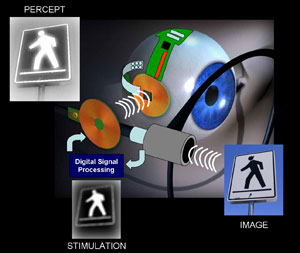Description of Our Retinal Prosthesis
A visual prosthesis must receive two types of input: 1) information about the visual scene ("visual signal") and 2) power and data to run the electronics and stimulate the retina in order to generate the corresponding visual image.Given that it is undesirable for the purposes of long-term implantation to have wires penetrating the body or imbedded batteries that have a limited life time and need to be replaced, it is necessary to send the visual signal and power to the implant without the use of wires. Wireless communication in our current design uses radiofrequency ("RF") transmission with a transmitting coil located on the arm of a specially designed pair of glasses transmitting data and power to receiving coils located on the prosthesis.
A visual scene captured by a camera and subsequently analyzed in order to be converted into an appropriate pattern of electrical stimulation. The data and power information that drive the stimulation electrodes are transmitted wirelessly to a receiving coil located on the prosthesis. Electrical current passing from individual electrodes (implanted within the retina) stimulate cells in the appropriate areas of the retina corresponding to the features in the visual scene.
[Click here for an interactive version of the prosthesis!

